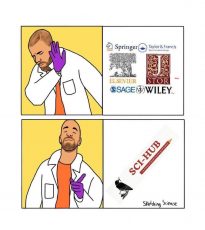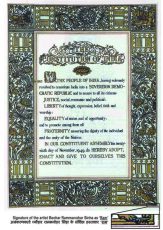Topical Highlight

Image from here
Sci-Hub and Libgen Up against Academic Publishers: A Death Knell for Access to Research? – Part I
In this three-part post, Nikhil dissects the ongoing copyright litigation in the Delhi High Court by three big publishing houses, namely Elsevier, Wiley and ACM against the shadow libraries Libgen and Sci-Hub, alongwith the interpretive issues before the court. In Part I, he explains the background of the dispute and analyses the dynamic injunction plea sought by the plaintiffs. He argues that a thorough examination should be carried out before categorising the defendant websites as ‘rogue’. He notes pertinently that a sample size of hundred or so articles might not be sufficient to establish infringement to an extent where the total scope of works runs over 84 million each. He argues that the common practice by some courts to not be particularly careful in structuring the dynamic injunction orders and giving broad-worded reliefs can misused by the plaintiffs, thereby unreasonably constraining free speech. In this light, he concludes that caution must be exercised in structuring a dynamic injunction relief if it is granted.
 Sci-Hub and Libgen Up against Academic Publishers: A Death Knell for Access to Research? – Part II
Sci-Hub and Libgen Up against Academic Publishers: A Death Knell for Access to Research? – Part II
In Part II, Nikhil analyses the applicability of a fair dealing exception to the case and argues that a strong case can be made that the use of copyrighted works by the defendants amounts to a fair dealing of the copyrighted works for purpose of research under Section 52(1)(a) of the Copyright Act. He analyses the functioning of Libgen and Scihub as per the US four-factor test incorporated by the Delhi High Court in India TV Independent News Service Pvt. Ltd. v. Yashraj Films Pvt. Ltd. to interpret fair dealing. He argues that in the instant case, the purpose of use of the copyrighted works by the defendants is to ensure adequate access to paywalled articles to facilitate research. He then argues that if the court concludes that defendants’ use indeed amounts to ‘fair dealing’ based on the four-factor test, the next question would be to see if it falls within the scope of sub-section (a)(i). He notes that in light of precedent, the provision could be interpreted to include use of works that facilitates research. Finally, he concludes that accepting the defendants’ fair dealing arguments would not set a dangerous precedent as is feared since the assessment will be particular to the case at hand, which is peculiar because of the defendants’ non-profit nature and lack of impact on the owner’s market.

Image from here
Sci-Hub and Libgen Up against Academic Publishers: A Death Knell for Access to Research? – Part III
Finally, in Part III, Nikhil analyses the applicability of the educational use exception provided under Section 52(1)(i) of the Act (which was found applicable in the DU photocopy case) to this case. He argues that if the court decides against the defendants in this case, that will mean that the applicability of this exception will become minimal. He also analyses whether the three-pronged test for grant of an interim injunction has been satisfied in this case. He notes that the plaintiffs have approached the courts after almost a decade of the existence of defendant websites, and thus, their probability of securing the interim injunction should be minimal. Therefore, the court should be wary of granting any relief until the trial is completed and the facts and law have been thoroughly examined. Finally, he hopes that the court factors in the different considerations of a developing nation like India as against the developed nations where the defendant websites have presently been blocked, because this litigation can have a massive impact on the research potential of the country.
Thematic Highlight

Image from here
Copyright and the Sci-Hub/Libgen Case: A Constitutional Query
In this post, Saral Minocha writes about the ongoing copyright litigation in the Delhi High Court by three big publishing houses, namely Elsevier, Wiley and ACM against the shadow libraries Libgen and Sci-Hub. He argues that an interpretation of our copyright law which allows the plaintiffs to prevail in this ongoing litigation restricts the right to free speech as granted in Article 19(1)(a), and does not have basis in any ground in Article 19(2). Saral notes that unlike in the US, the argument that speech infringing copyright is unprotected is not an attractive argument with respect to the Indian Constitution since Indian Courts are not left free to determine grounds on which the right granted under Article 19(1)(a) can be restricted. Further, he demonstrates how copyright law that prohibits access to educational materials is not covered by any of the restrictions under Article 19(2). He notes that copyright law has to be subject to Article 19(1)(a) not just because of Article 13 (which provides that laws infringing fundamental rights are void to the extent of infringement), but also because of Article 245 (which provides for power of Parliament to legislate). Finally, he concludes that these discrepancies can be resolved if copyright law is amended to make educational materials available at a reasonable cost or if a clarification is made in the exceptions to infringement so that copyright does not inhibit research. Otherwise, he notes that the Constitution could be amended to include “copyright” as a ground in Article 19(2).
Other Posts
 A Look Back at India’s Top IP Developments of 2020
A Look Back at India’s Top IP Developments of 2020
Unfortunately, many traditions worldwide had to be broken the past year, but at SpicyIP we gladly continued our annual tradition of recounting all the significant developments that impacted the Indian IP landscape in 2020. This year, we divided these developments into four categories: a) Top 10 IP Judgments/Orders (Topicality/Impact); b) Top 10 IP Judgments/Orders (Jurisprudence/Legal Lucidity); c) Top 10 IP Legislative and Policy Related Developments; and d) Top 10 Other IP Developments. We also included a list of other notable IP developments of 2020 here and we informed viewers of a list of the most read posts on the blog in 2020 here.

Image from here
‘Jhund’ Injunction Order: Copyright and Personality Rights in Real Life Stories
In this post, Shivam Kaushik analyses the Telangana High Court’s order granting an interim injunction restraining the release of the film ‘Jhund’ in October this year. This restraining order was passed due to potential copyright and personality right infringement. He criticises the reasoning of the High Court because as per precedent [R.G. Anand v. Deluxe Films (1978)], which the High Court cites itself but does not follow or distinguish—similarity in plot, depiction, life and the life and story of protagonist is insufficient to constitute infringement. He pertinently points out that without access to the plaintiff’s script, it was impossible that the film’s story could be a substantial and material copy of it. He analyses the jurisprudence around the right of publicity in India, as per which only that which is not on the public record cannot be revealed. He argues that the life story of Defendant No. 1 received heavy publicity when it was showcased in an episode of popular TV show ‘Satyamev Jayate’ and it became a part of public record, eroding the element of privacy and the publicity rights in it. Therefore, he concludes that the reasoning of the High Court in holding that copyright can exist in life stories is unconvincing and unreasonably expands the scope of copyright and personality rights.
 Tenability of Passing Off Action against “COVISHIELD” of Serum Institute of India
Tenability of Passing Off Action against “COVISHIELD” of Serum Institute of India
In this post, Mathews examines a passing off suit filed by a Nanded-based pharmaceutical company, Cutis Biotech, claiming to be the lawful and the prior user of the tradename “Covishield” against Serum Institute of India. He argues that Cutis Biotech’s use of the tradename “Covishield” for products such as surface decontaminant, fruit and vegetable wash and antiseptic is descriptive since these products “shield” one from “covid”. Thus, he notes that Cutis Biotech can obtain protection for “Covishield” if (i) the mark loses its primary meaning of shielding one from corona; and (ii) enables the consumer to identify the source of the product as Cutis Biotech, which is a question of fact. He concludes that it will be arduous to prove that “Covishield” has acquired a secondary meaning. Similarly, the Serum Institute would also have to satisfy a higher burden of proof for obtaining and defending trademark protection for “Covishield” (if at all the mark reaches that stage).

Image from here
The Legality of the Appointment of the 5 Technical Members to the IPAB
In this post, Prashant briefly describes the advertisements, The Tribunal Rules, 2020, Selection Committee recommendations of 5 shortlisted candidates and the Appointments Committee Cabinet approval of the same, pursuant to which the appointments of 5 Technical Members to the IPAB were made. He argues that these appointments are illegal for two reasons. Firstly, under the Tribunal Rules, 2020, practising lawyers can be appointed to the IPAB as Technical Members only if they have 25 years of experience in copyright or trademarks, depending on the role for which they are being appointed. He notes that it is quite obvious from reading the bios of the Technical Members on the website of the IPAB that most of them (not all) do not appear to have the 25 years of experience required under the 2020 rules. Secondly, presuming that the appointments were made under the law that existed prior to the 2017 rules, the entire process of advertisement, selection and appointment should have been completed prior to the notification of the new Tribunal Rules, 2020 on 12th February, 2020 because the moment the Tribunal Rules, 2020 came into effect in February, the legal framework under which the advertisement in 2018 were issued ceased to exist. He notes that since this was not done, the appointments are illegal. He concludes that the correct course of action would have been to re-advertise the posts after the new tribunal rules came into effect on 12th February, 2020.
Decisions from Indian Courts
Other News from around the Country
News from around the World